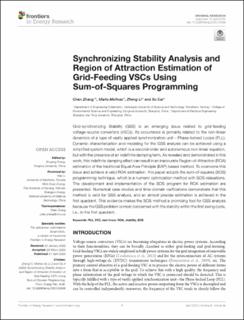| dc.contributor.author | Zhang, Chen | |
| dc.contributor.author | Molinas Cabrera, Maria Marta | |
| dc.contributor.author | Zheng, Li | |
| dc.contributor.author | Cai, Xu | |
| dc.date.accessioned | 2021-01-21T15:51:41Z | |
| dc.date.available | 2021-01-21T15:51:41Z | |
| dc.date.created | 2021-01-20T01:39:40Z | |
| dc.date.issued | 2020 | |
| dc.identifier.citation | Frontiers in Energy Research. 2020, 8 (4), 56-66. | en_US |
| dc.identifier.issn | 2296-598X | |
| dc.identifier.uri | https://hdl.handle.net/11250/2724178 | |
| dc.description.abstract | Grid-synchronizing Stability (GSS) is an emerging issue related to grid-feeding voltage-source converters (VSCs). Its occurrence is primarily related to the non-linear dynamics of a type of vastly applied synchronization unit – Phase-locked Loops (PLL). Dynamic characterization and modeling for the GSS analysis can be achieved using a simplified system model, which is a second-order and autonomous non-linear equation, but with the presence of an indefinite damping term. As revealed and demonstrated in this work, this indefinite damping effect can result in an inaccurate Region-of-Attraction (ROA) estimation of the traditional Equal Area Principle (EAP)-based method. To overcome this issue and achieve a valid ROA estimation, this paper adopts the sum-of-squares (SOS) programming technique, which is a numeric optimization method with SOS relaxations. The development and implementation of the SOS program for ROA estimation are presented. Numerical case studies and time-domain verifications demonstrate that this method is valid for GSS analysis, and an almost precise estimation is achieved in the first quadrant. This evidence makes the SOS method a promising tool for GSS analysis because the GSS problem is most concerned with the stability within the first swing cycle, i.e., in the first quadrant. | en_US |
| dc.language.iso | eng | en_US |
| dc.publisher | Frontiers Media | en_US |
| dc.rights | Navngivelse 4.0 Internasjonal | * |
| dc.rights.uri | http://creativecommons.org/licenses/by/4.0/deed.no | * |
| dc.title | Synchronizing Stability Analysis and Region of Attraction Estimation of Grid-Feeding VSCs Using Sum-of-Squares Programming | en_US |
| dc.type | Peer reviewed | en_US |
| dc.type | Journal article | en_US |
| dc.description.version | publishedVersion | en_US |
| dc.source.pagenumber | 56-66 | en_US |
| dc.source.volume | 8 | en_US |
| dc.source.journal | Frontiers in Energy Research | en_US |
| dc.source.issue | 4 | en_US |
| dc.identifier.doi | 10.3389/fenrg.2020.00056 | |
| dc.identifier.cristin | 1875020 | |
| dc.description.localcode | © 2020 Zhang, Molinas, Li and Cai. This is an open-access article distributed under the terms of the Creative Commons Attribution License (CC BY). The use, distribution or reproduction in other forums is permitted, provided the original author(s) and the copyright owner(s) are credited and that the original publication in this journal is cited, in accordance with accepted academic practice. No use, distribution or reproduction is permitted which does not comply with these terms. | en_US |
| cristin.ispublished | true | |
| cristin.fulltext | original | |
| cristin.qualitycode | 1 | |

